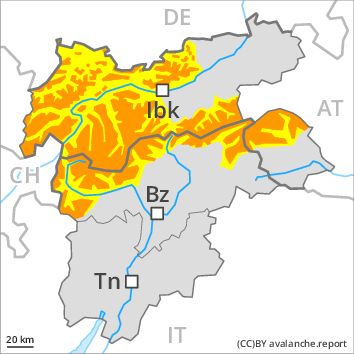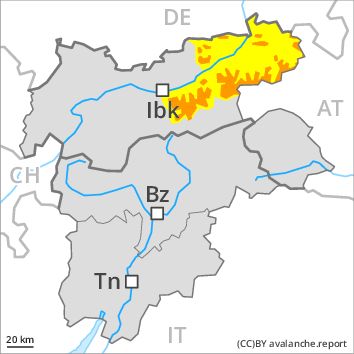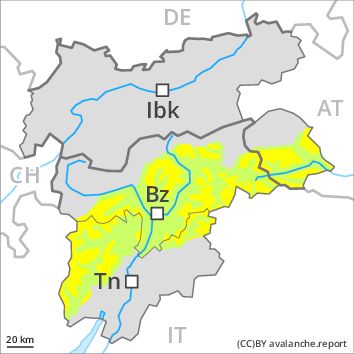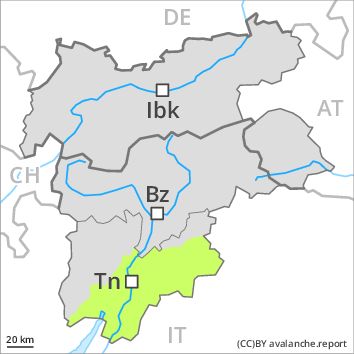Regions
Val Müstair Alps, Western Verwall Mountains, Langtaufers, Eastern Verwall Mountains, Schnals Ridge, Silvretta, Southern Stubai Alps, Samnaun Mountains, Southern Zillertal Alps and High Tauern, Northern Oetz and Stubai Alps, Saldurn-Mastaun Ridge, Texel Mountains, Glockturm Range, Durreck Range, Weißkugel Range, Western Rieserferner Mountains, Gurgler Range, Central Stubai Alps, Ortler Range, Northern Zillertal Alps, Allgäu Alps, Venediger Range, Eastern Lechtal Alps - Ammergau Alps, Mieming Mountains, Eastern Rieserferner Mountains, Karwendel Mountains, Glockner Range, Western Lechtal Alps, Central Lechtal Alps, Grieskogel Mountains

Danger level
Danger Level 3 - Considerable above the treeline
Danger Level 2 - Moderate above the treeline
Avalanche Problem
Wind-drifted snow above the treeline, N-NE-E-SE-S-SW-W-NW
Wet snow above the treeline, N-NE-E-SE-S-SW-W-NW

Increase in danger of dry avalanches as a consequence of fresh snow and stormy weather.
As a consequence of the snowfall, the likelihood of dry avalanches being released will increase appreciably especially above the tree line. Especially in places where the wind is storm force the avalanche danger is greater. The number and size of avalanche prone locations will increase as the day progresses. The avalanche prone locations are to be found in particular on wind-loaded slopes of all aspects. They will increase with altitude. The brittle wind slabs will be covered with fresh snow in some cases and therefore difficult to recognise.
In addition as the day progresses still more individual wet and gliding avalanches are possible. This applies in particular in starting zones below the tree line that have retained the snow thus far.
Snowpack
dp 6: cold, loose snow and wind
dp 2: gliding snow
Over a wide area persistent snowfall to low altitudes. 30 to 50 cm of snow. will fall. The northwesterly wind will transport the fresh snow significantly. As a consequence of fresh snow and a storm force to violent wind from northwesterly directions, brittle wind slabs will form in all aspects. These will be deposited on soft layers.
Tendency
The avalanche danger will persist.
Regions
Western Tuxer Alps, Eastern Tuxer Alps, Brandenberg Alps, Western Kitzbühel Alps, Wilder Kaiser Mountains - Waidring Alps, Eastern Kitzbühel Alps

Danger level
Danger Level 3 - Considerable above the treeline
Danger Level 2 - Moderate above the treeline
Avalanche Problem
Wind-drifted snow above the treeline, E-SE-S-SW

Fresh wind slabs above the tree line.
As a consequence of the snowfall, the likelihood of dry avalanches being released will increase appreciably especially above the tree line. Especially in places where the wind is storm force the avalanche danger is greater. The number and size of avalanche prone locations will increase as the day progresses. The avalanche prone locations are to be found in particular in east to south to southwest facing aspects and adjacent to ridgelines and in gullies and bowls. They will increase with altitude. The brittle wind slabs will be covered with fresh snow in some cases and therefore difficult to recognise.
Snowpack
dp 6: cold, loose snow and wind
Over a wide area persistent snowfall to low altitudes. Up to 30 cm of snow. will fall. The northwesterly wind will transport the fresh snow significantly. As a consequence of fresh snow and a storm force to violent wind from northwesterly directions, brittle wind slabs will form in particular on east, south and southwest facing slopes. These will be deposited on soft layers.
Tendency
The avalanche danger will persist.
Regions
Sexten Dolomites, Eastern Pfunderer Mountains, Latemar, Western Deferegger Alps, Ulten Valley, Eastern Nonsberger Alps, Northern Dolomites of Fiemme, Gröden Dolomites, Southern Adamello, Eastern Deferegger Alps, Prags Dolomites, Sarntal Alps, Adamello - Presanella, Schober Mountains, Western Pfunderer Mountains, Northern Brenta - Peller, Lienzer Dolomites, Western Nonsberg Alps, Southern Brenta, Fassa Valley, Sole, Pejo and Rabbi, Maddalene

Danger level
Danger Level 2 - Moderate above the treeline
Danger Level 1 - Low above the treeline
Avalanche Problem
Wind-drifted snow above the treeline, N-NE-E-SE-S-SW-W-NW

Fresh wind slabs above the tree line.
As a consequence of the snowfall, the likelihood of dry avalanches being released will increase a little especially above the tree line. Especially in places where the wind is storm force the avalanche danger is greater. The number and size of avalanche prone locations will increase as the day progresses. The avalanche prone locations are to be found in particular adjacent to ridgelines and in gullies and bowls in all aspects. They will increase with altitude. In the regions neighbouring those that are subject to danger level 3 (considerable) the avalanche danger is higher.
Snowpack
dp 6: cold, loose snow and wind
5 to 15 cm of snow. will fall. The northwesterly wind will transport the snow. As a consequence of fresh snow and a storm force wind from northwesterly directions, brittle wind slabs will form in particular on east, south and southwest facing slopes.
Tendency
The avalanche danger will persist.
Regions
Primiero - Pale di S. Martino, Prealps, Cembra Valley, Bondone and Stivo, Vallarsa, Folgaria - Laverone, Southern Lagorai, Ledro Valley, Northern Lagorai, Paganella, Marzola - Valsugana, Pine' - Mocheni Valley

Danger level
Danger Level 1 - Low
Avalanche Problem
Wet snow above 2000m, SE-S-SW-W
Wind-drifted snow above the treeline, N-NE-E-SE-S-NW

As a consequence of fresh snow and stormy weather the avalanche prone locations will become more prevalent as the day progresses.
Fresh and somewhat older wind slabs are mostly rather small and can be released by large loads in particular. At high altitudes and in high Alpine regions avalanche prone locations are a little more prevalent. A clear night will be followed in the early morning by quite favourable conditions generally, but the danger of wet and gliding avalanches will increase later. In steep terrain there is a danger of falling on the icy crust.
Snowpack
The snowpack will be in most cases well bonded. The sometimes storm force wind will transport the fresh snow. Adjacent to ridgelines and in gullies and bowls mostly small wind slabs will form. Faceted weak layers exist in the old snowpack in particular on rather lightly snow-covered shady slopes.
Tendency
The wind will be moderate to strong at times in some localities.




